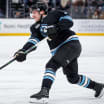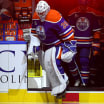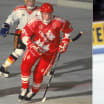The Coaches Room is a regular feature throughout the 2022-23 regular season by former NHL coaches and assistants who will turn their critical gaze to the game and explain it through the lens of a teacher. Phil Housley and Mark Recchi will take turns providing insight.
In this edition, Housley, a Hall of Fame defenseman who coached the Buffalo Sabres and was an assistant with the Nashville Predators and Arizona Coyotes, discusses the importance of goal differential and creating 5-on-5 scoring.
Coaches stress goal differential, 5-on-5 scoring as keys to NHL success
Housley discusses why most teams in playoff position thrive in 2 important areas

By
Phil Housley
Special to NHL.com
Two things that are really important to making the Stanley Cup Playoffs are your goal differential -- total goals scored minus total goals against -- and 5-on-5 scoring. I did a study when I was coaching the Buffalo Sabres, and 95 percent or more of the teams that have a positive goal differential qualify for the playoffs.
All the teams in playoff spots this season have a positive goal differential except for the Los Angeles Kings, who are minus-1. Sometimes that has to do with your goaltending and goals against, and the Kings are 21st in the NHL in allowing 3.36 goals per game. It could also be your team has been depleted with injuries and you don't have your full lineup.
But if you look at the Eastern Conference, all the teams in playoff spots have positive goal differentials.
And 5-on-5 scoring is a big part of that.
Eight of the top 11 teams in 5-on-5 scoring are either in or tied for playoff spots. Two of the teams that aren't in a playoff spot are the Florida Panthers and San Jose Sharks, who are tied with the Washington Capitals and Toronto Maple Leafs for fourth in 5-on-5 goals with 91.
The Panthers were without forward Aleksander Barkov (10 games) and defenseman Aaron Ekblad (11 games) because of injuries, but now that they're back, I think they are going to be a really formidable team that's going to be tough to beat. And though the Sharks score a lot 5-on-5, they are also 31st in the NHL in 5-on-5 goals against with 106.
The Sabres, who are tied the New York Rangers for 10th in 5-on-5 goals with 88, also are not in a playoff spot, but they are having a great season and only four points behind the Pittsburgh Penguins and New York Islanders, who are tied for the second wild card into the playoffs from the Eastern Conference.
There are a lot of way teams are generating offense to get these good 5-on-5 numbers and be in the positive in goal differential. There is always a rush component to it where teams attack the offensive zone with speed and their defensemen are jumping up and they're trying to create odd-man-rush situations.
In the offensive zone, one of the components that goes into 5-on-5 scoring is a low attack below the goal line. A lot of teams are using behind the net. This isn't something new, but some teams do it better than others and they're changing their point of attack.
There is a high attack where the defensemen are getting involved, whether it's a dive or a defenseman down the wall or a high third forward, where the defenseman can kick the puck back. If you look at the Colorado Avalanche, who are banged up with injuries and aren't in a playoff spot right now, but they really generate a lot from defensemen getting involved in the offensive zone.
It's not unusual to see a lot of these teams where defensemen are below the goal line because they're part of the 5-on-5 attack. Instead of just sitting on the blue line, the defensemen are getting more involved in the cycle part of the game.
That makes it tough on the defensive team because you're changing your point of attack. Some teams play man on man, some teams play zone defense, but there are a lot of little decisions that need to be made under those circumstances.
Another big thing for me is the inner-slot offense and the shots from the slots. I think those teams that create the most inner-slot shots and shot attempts from the slot are among the best in 5-on-5 scoring.
A lot of teams just have a shot mentality. The Carolina Hurricanes have been among the top teams in shot attempts for years and the just shoot pucks to create.
Some teams don't want to give the puck up. They are built heavy up front and they want to grind you. And then there are teams that can play both ways.
When a shot is taken, there are a lot of things that occur. The defensive team is looking for the puck. The offensive team is going to the puck. They seem to know where the puck is going to go because they are facing towards the net and they're converging on the net. So, they have a little bit of an advantage unless the rebound comes directly to a defensive player.
If you look at the teams that are in playoff positions that aren't in the top 10 in 5-on-5 scoring, such as the Dallas Stars, Winnipeg Jets, Minnesota Wild, Calgary Flames and Edmonton Oilers from the Western Conference, those teams are solid on the power play, other than the Flames, who are 24th in the League at 19.7 percent, and they all have positive goal differentials.
Power play and penalty kill percentage, if your total is 100-plus, that can also help in goal differential. The Tampa Bay Lightning, who are third in the Atlantic Division, are tied with the Jets for 20th in 5-on-5 goals with 80, but they are sixth on the power play at 26.7 percent, 11th on the penalty kill at 81.1 percent and have a plus-21 goal differential.
It's just crazy where you see the power-play percentages now. There are 22 teams in the NHL that are scoring on at least 20 percent of their power-play chances this season and that wasn't the case not too long ago. In 2015-16, there were eight.
That could be a story for another day, but I think continuity of players that have been together for a while and good coaching concepts have a lot to do with the improvements on the power play. And that sort of mirrors your 5-on-5 game.
If your 5-on-5 game is really good, your power play is often an extension of that, and when your 5-on-5 game is suffering, it seems like your power play suffers, too.
But, to me, the teams that are going to go the farthest in the playoffs, their 5-on-5 scoring is usually very good. In the playoffs, there are teams with good penalty kills and there are going to be times where you power play is not clicking and you're going to need to fall back on your 5-on-5 scoring.

















